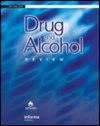Integrating routine screening for pregnancy intention and contraceptive use into care of women who use alcohol or other drugs
Abstract
Introduction
There are high rates of unplanned pregnancy and low rates of contraceptive use in women with substance use disorders. Women who use drugs experience many barriers to health. In addiction treatment services in New South Wales, Australia, patients undergo routine health screening on treatment entry and annually thereafter. An integrated pregnancy and contraceptive screening tool was developed. The aim of this cross-sectional study was to report the feasibility and preliminary outcomes of this tool.
Methods
A pregnancy intention screening (PIS) tool was developed and integrated into the electronic medical record and the annual routine screening. This tool consisted of four yes/no questions about current pregnancy, future pregnancy plans and contraceptive use. Responses to these questions are reported. Descriptive statistics were used to report demographic and outcome data.
Results
One hundred women were offered and completed the survey. There were low rates of effective or highly effective contraceptive use (24.5 percent of eligible participants). Seventy-four percent of participants wanted further information on contraception.
Discussion and Conclusions
As with other studies, our studies demonstrate low rates of contraceptive use and high rates of interest in contraception use among women who use drugs. The PIS tool was completed by all women to whom it was offered, suggesting high levels of patient acceptability. Integration of a PIS tool was effective in identifying women with contraceptive needs and was acceptable to women.


 求助内容:
求助内容: 应助结果提醒方式:
应助结果提醒方式:


